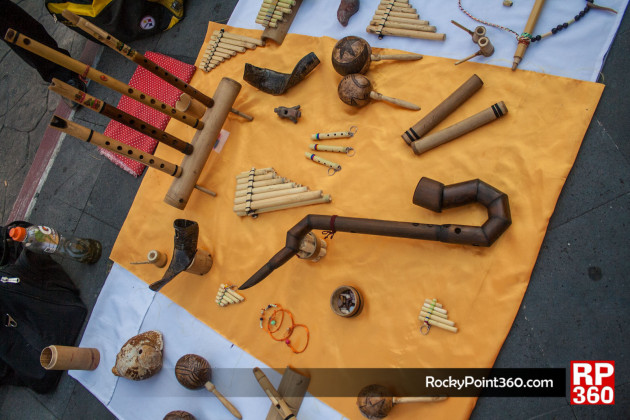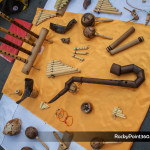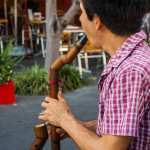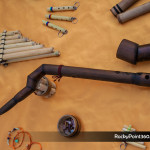We’re pleased to present this “travel scene” from one of our 360 writers who is out and about this summer.
By MoKa Hammeken
Walking through the center of Cuernavaca [Morelos] I was drawn to a singular melody; it seemed to be the voice of a saxophone, however I couldn’t spot the shimmering instrument.
It is quite common in these parts for constant dizzying movements to come together, the alternative and the cultural: skaters, people doing capoeira, break dancers, street musicians of all types, painters, people making and selling jewelry, and cultural promoters, all drinking coffee at cafés, greeting each other, hanging around and/or moving on.
Within this swarm of individuals, he suddenly appeared. The only thing I was able to see at first was a young man with inflated cheeks and an opaque curved object. Could it be? Curious, I drew closer. Precisely the sounds of a saxophone spilled out left and right from that strange serious object. I was fascinated that something so simple, light, hardly visually complicated (let’s say minimalist) could produce such beautiful sounds. I thought it was fabulous, brilliant, and original….. [see English below]
El extraño caso del saxofón de caña
Por MoKa Hammeken
 Caminando por el centro de Cuernavaca me llamó la atención una melodía singular; parecía la voz de un saxofón, sin embargo no veía yo el reluciente instrumento.
Caminando por el centro de Cuernavaca me llamó la atención una melodía singular; parecía la voz de un saxofón, sin embargo no veía yo el reluciente instrumento.
Es muy común por estos rumbos que se junte en un movimiento vertiginoso y constante, lo alternativo y lo culturero; skaters, gente que hace capoeira, break dancers, músicos callejeros de todo tipo, pintores, gente que hace y vende joyería, personas del ambiente de promoción cultural, tomándose un café en las cafeterías, todos se saludan, se quedan y/o siguen su camino.
Y en ese pulular de individuos, apareció de pronto. Lo único que primero alcancé a ver es a un joven con los cachetes inflados y un objeto opaco con forma curva. ¿Será? Me acerqué curiosa. Justamente de ese extraño y sobrio objeto salían los sonidos de un saxofón hecho y derecho. Me fasciné: algo tan simple, liviano, poco complicado visualmente (dijéramos de corte minimalista) y que pudiera producir sonidos tan agradables. Se me hizo fabuloso, genial y original.
No pude resistirme y me acerqué a platicar con él ¿de dónde lo había sacado?
Yo los vendo- me contestó y me señalo a su derecha un espacio en el piso en el que tenía otro saxofón y otros tantos instrumentos más- Y, yo los hago- continuó con una sonrisa tímida.
Su nombre es Cristóbal Salgado. Él hace y vende sus propios instrumentos musicales a base de caña de bambú, creatividad lo ha llevado a diversas exposiciones fuera del Estado de Morelos y a situarse todos los días de 6 a 9 en una cafetería frente a la Catedral de Cuernavaca.
Entonces ¿tú solo haces los instrumentos? ¿De dónde nació esta idea?
Si, yo solo los hago, desde el corte de la caña, la estética, la afinación. – Estudié música y teatro pero sí estoy metido más en la música, más que nada – y ríe- porque esto de hacer los instrumentos y venderlos son mis ingresos, y hago de diferentes tipos: de aliento, de viento, de percusión. La idea yo creo es que ya es por parte genética porque mi padre es laudero, entonces entiendo bastante bien como funcionan los instrumentos, aprendí algo de él y la verdad cómo vi que era sustentable dije “pues vamos a hacer instrumentos”. Y vender aquí (donde llevo como un año) ha sido muy bueno porque me he encontrado con muchos músicos y diferentes personas de muchos lados (fuera del estado, fuera del país) y es una gran satisfacción: que lo que haces lo valoren algunas personas y sobretodo que sea algo de utilidad. Tu sabes que un saxofón normal es caro, entonces obvio es que no todos tienen la posibilidad de tener un saxofón y tener uno así, de bambú es algo “pro” porque es resistente, tiene buen sonido, es ecológico pues el bambú lo cortas y vuelve a nacer; se reproduce muy rápido, se multiplica, no es como un árbol.
¿Cómo lo afinas? Ha de ser algo muy complicado-
La forma se hace y la afinación se realiza con un aparato electrónico; se le van haciendo los orificios bien y en su lugar, y la afinación ya queda, es cómo una quena, como una flauta y tiene un sonido muy natural- Se lleva la boquilla a la boca y toca tantito el saxofón de nuevo, haciendo que varias personas que vagaban alrededor se acerquen curiosas a ver el misterioso objeto.
-¿Entonces llevas haciéndolos desde hace un año más o menos?- Pregunto
 No- contesta mientras le regresa el cambio a unas personas que compraron dos maracas- En esto, con los saxofones, llevo alrededor de cuatro años. He tenido que irlos perfeccionando. La verdad es que aquí no tiene que ver mucho la inspiración, sólo trabajo duro para que salgan bien las notas… Ya la inspiración viene cuando el instrumento suena bien y van saliendo las notas y aún así, hay que estudiarle y saber para que salgan bien-
No- contesta mientras le regresa el cambio a unas personas que compraron dos maracas- En esto, con los saxofones, llevo alrededor de cuatro años. He tenido que irlos perfeccionando. La verdad es que aquí no tiene que ver mucho la inspiración, sólo trabajo duro para que salgan bien las notas… Ya la inspiración viene cuando el instrumento suena bien y van saliendo las notas y aún así, hay que estudiarle y saber para que salgan bien-
-De las primeras veces eran meramente ornamentales y poco a poco, ya después le fui dando la afinación conforme fui teniendo más conocimiento sobre el instrumento y así. También fue por los mismos compradores, que lo veían y me decían ; “¿ no toca?”. A mi no me satisfacía que fuera solo un objeto de adorno inútil que simulaba ser un instrumento y de ahí me agarré para hacerlo que sonora, y no solo que sonara, sino que sonara bien, cómo debe de ser, cómo debe de oírse un saxofón. Cuatro años perfeccionando hasta hacerlo lo que es ahorita, un verdadero instrumento musical profesional bien afinado- Volvió a arrancarle melodías con un toque de jazz que alegró a una pareja de extranjeros
Lo interesante es que ya no hay tantos lauderos de viento y de aliento- continuó- entonces eso también da cierto prestigio, además de que mi padre también es laudero y entre músicos eso es muy importante.
El cielo se empezaba a ponerse de un gris azulado intenso y por andar paseando ya ni supe dónde había quedo el amigo con el que iba, me le desaparecí por andar de distraída.
Antes de irme, le pedí permiso para tomarle algunas fotos mientras tocaba y así seguir mi camino (o mi búsqueda). Parte de su trabajo también era hipnotizar a los transeúntes con sus notas, atraerlos a su espacio y convertirlos en clientes, y yo ya le había quitado algo de tiempo, aunque siempre me platicó con una enorme sonrisa sincera.
No me podía quitar la idea de la cabeza: un saxofón de caña de bambú que sonaba como uno profesional y que tan sólo costaba $400 pesos. Me conforta saber que siempre hay gente que hace la música esté al alcance de todos. Otro de los tantos talentosos y misteriosos seres que habitan en el planeta.
The strange case of the bamboo reed sax (cont.)
….I couldn’t resist, so I drew closer to speak with him, “Where did you get that?”
“I sell them,” he responded and pointed to a spot on the ground to his right where he had another saxophone and other instruments. “And, I make them,” he continued with a shy smile.
His name is Cristóbal Salgado. He makes and sells his own musical instruments out of bamboo reeds. This creativity has taken him to different exhibitions outside of Morelos, and finds him from 6 – 9 p.m. at a café in front of the Cathedral in Cuernavaca.
“So,” I pried, “do you make these instruments alone? Where did this idea come from?”
“Yes, I do them alone, from cutting the reeds, the aesthetic, the tuning. I studied music and theater, though I’ve gotten more into music than anything,” he laughs, “because making and selling instruments is my income, and I make different types: wind instruments and percussion. The idea, I believe, is genetic as my father is a luthier [instrument maker] so I know pretty well how instruments function. I learned some from him and honestly when I saw it was sustainable I said, ‘well, let’s make instruments’ ..and sell, I’ve been here about a year. It has been very good because I have met many musicians and different people from all over (out of state, from other countries) and it’s wonderfully satisfying when what you do is valued by some, and above all that it is useful. You know that a normal saxophone is expensive, so obviously not everyone is able to have a saxophone. Having one like this, out of bamboo, is “pro” because it is resistant, has a good sound, and is ecologically friendly because when you cut bamboo it grows again, it reproduces quickly and multiplies, it’s not like a tree.”
“How do you tune it, it must be quite complicated?”
“The form and tuning are done with an electronic device; the holes are made in their spots, and the tuning is set. It’s like a [South American] quena, like a flute that has a very natural sound.” He pulls the mouthpiece up and begins to play a little saxophone again, making various persons who are wandering nearby come closer to look curiously at this mysterious object.
“So, you’ve been doing this for more or less a year?” I ask.
“No,” he responds as he gives change to a few people who bought maracas. “With this, with the saxophone, I’ve been doing it around four years. I have had to perfect it. Truthfully this doesn’t have much to do with inspiration, only working hard to get the notes out…and the inspiration comes when the instrument sounds good and the notes are coming out, and even then you need to study and know how to get them out well.”
“The first ones were merely ornamental and after that I started tuning them as I learned more about the instrument. It was also because of the buyers themselves who would see it and ask, “Does it play?” I was not satisfied that it was only a useless adornment that only looked like an instrument. So I set to giving it a sound, and not only a sound but making it sound good, as it should be, as a saxophone should sound. Four years perfecting it until making it what it is now, a true professional well-tuned musical instrument.” He started playing again, melodies with a touch of jazz to the delight of a foreign couple.
“What is interesting,” he continued, “is that there aren’t many wind instrument luthiers, so that also has some prestige, plus my father is a luthier and among musicians that is very important.
The sky began to transform into an intense blue grey, and from wandering around I had lost track of the friend with whom I arrived.
Before leaving I asked if I could take some pictures while he played and then continue my walk (or my search). Part of his work was also to hypnotize passersby with his notes, drawing them into his space and transforming them into clients. I had already taken up much of his time although he always spoke with an enormous sincere smile.
I couldn’t get the idea out of my head: a saxophone made of bamboo reed that sounded like a professional saxophone and yet only cost 400 pesos. I’m comforted in knowing there are always people that make music within the reach of everyone. Another of the many talented and mysterious beings that inhabit the planet.
Translation: SKR






